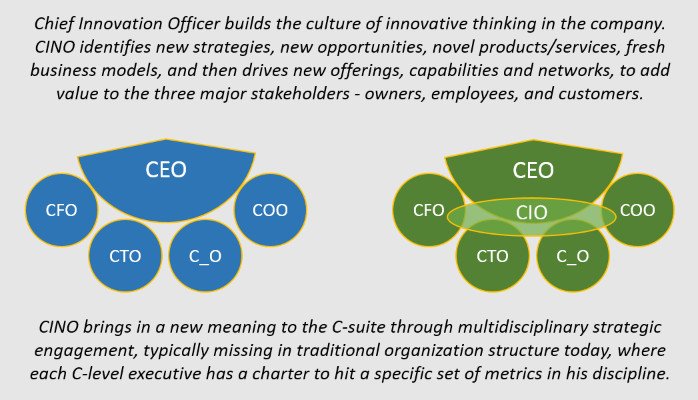Who needs a “Chief Innovation Officer” – Only those who want to grow, right?
For many years, companies have over-focused on techniques such as Lean and outsourcing to reduce cost. Now, they are waking up to a realization that long-term growth comes from innovation – creating new products, new service or new ways of generating value for customers and employees.
On very similar lines the book ‘Team of Teams’ from General Stanley McChrystal says ‘an efficient system is not always effective’. Efficiency in commercial setting would drive profit margins, but effectiveness would drive sales and growth.
Which business needs both productivity (efficiency) and innovation (effectiveness)? Only the ones that want to grow, right?
Over the recent few years, we have come to accept that innovation is not just new products, but anything new that adds value; then it must cover every discipline, every facet, every product, every process, and every employee of an organization. Perhaps, it is a way of thinking, just like quality.
In my interaction with various companies, I am beginning to see that the C-level leaders are getting laser focused on their discipline: COO on operational excellence and delivery, CFO on financial metrics, CTO on product R&D, CSO on customer engagement, with CEO keeping them all together for success today, while he also needs to prepare for tomorrow. I also see that Innovation happens in each of these quarters, in somewhat of a dis-connected fashion, and generally dies out, due to acceptance challenges, i.e., internal friction and inertia. For companies to grow and truly make innovation effective, it has to be a corporate level initiative with another C-level individual at the helm, who would also keep the entire C-suite on the same page, supporting the CEO with tomorrow in mind. While most departments review lagging metrics, the metrics for innovation need to be the leading metrics for business growth.
I agree with Bill Poston definition – ‘A successful Chief Innovation Officer is a master of influence. They formulate strategy and establish a coalition of individuals across business units, functions, and geographies to improve the execution of all types of innovation. This includes innovation beyond products to include service, business model, channel and commercial innovation’. Bill goes on to define the role, and I would endorse a few important ones here
- Formulate and communicate innovation strategy
- Shape and manage the corporate innovation portfolio
- Identify disruptive threats and opportunities based on trends
- Cultivate and sponsor breakthrough innovation initiatives
- Evolve innovation business disciplines and competencies
- Create and nurture a culture conducive to innovation
Accenture’s research in 2008 summarized the status of corporate innovation around the world. Overall, the research revealed that innovation is a top priority for companies seeking to increase their revenues, but they usually get a poor return on their investment because of flaws in managing it, such as not having a single executive in charge (now called Chief Innovation Officer). Accenture expressed that poor returns can be turned into profitable, sustainable growth if innovation is systematically managed end to end, with the same rigor and discipline as other major business processes.
So, do you need a Chief Innovation Officer? Well, only if you want to grow, right?



